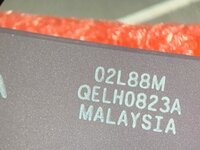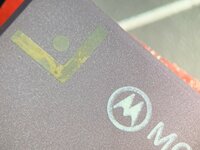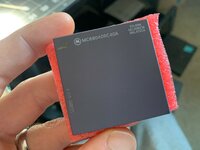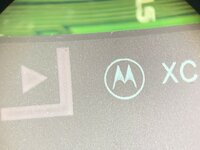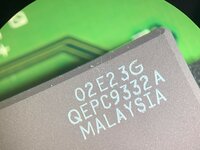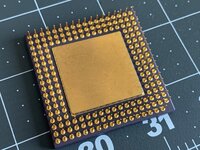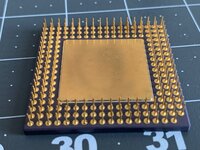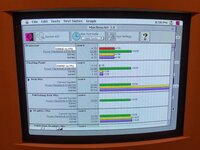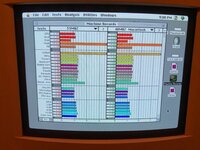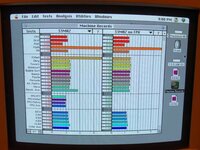Some recent activities that I’m doing with my vintage Macs have prompted me to source Motorola / Freescale / NXT 68040 CPUs for use in Macintosh LC 475, Quadra 605, and other Centris/Quadra models.
I’ve placed this thread under the Quadra category because it deals with the 68040 processor. If anyone with Amiga experience can recommend a sub forum category that involves 68040 CPUs I’ll create a post there that references this thread. I’d appreciate someone reply with models for that.
This is just a placeholder / preliminary post that will be updated as I gather more information, photos, evidence, and specifications.
To summarize, there are a lot of fake 68040 and 68LC040 CPUs out there. I feel this is the forum that fakes on eBay can be discussed openly and freely, and sellers could be outed as a warning to others not to buy from those sellers known to selling fakes.
So, what is a fake? How can you fake a CPU?
Briefly, and I’ll go into more detail in the coming weeks and months, it involves removing the labeling on the top of the CPU as printed by Motorola or Freescale, and replacing those markings with ones making the CPU appear better than it is.
The 68040 CPU is usually marked as the following:
XC68040RC20
XC68040RC25
XC68LC040RC25
XC68040RC33
XC68040RC40
MC68040RC20
MC68040RC25
MC68LC040RC25
MC68040RC33
MC68LC040RC33
MC68040RC40
There are some early batches of 68040 which bear the PC68040RC25 and so on, which are prototype CPUs.
The above list is not exhaustive by any means but only indicates the most common ones found and used in Macintosh computers.
The first letter (X or M) refers to whether the part was fully qualified or not. When Motorola was working on the 68040 series, they had bugs and glitches (called errata) that results in them not being “fully qualified”. Those earlier batches had XC as their prefix. The MC are fully qualified parts, which shipped basically after Apple stopped using 68040 CPUs, so nearly all CPUs in Macintosh computers are the XC part.
The LC in the number refers to a CPU that lacks an embedded floating point math coprocessor inside. Most people don’t use software that takes advantage of the FPU, but some have found that it’s possible that Mac OS 8.1 utilizes the FPU in OS operations. I haven’t confirmed that.
When combining an XC part with an LC, you end up with software incompatibility with software needing an FPU, and those apps crash. The software “SoftFPU” did not properly function on those chips, because of the errata that those CPUs had. The MC part fixes this glitch and allows them to work properly.
The RC in the part number refers to the package itself. The ceramic ZIFF type CPU is RC, and used in all desktop Mac’s and Amigas (as far as I know). The FC part is one used in laptops and some upgrade cards, it required soldering the legs to surface Mount pads and is packaged in a smaller plastic type package.
These days, there are a lot of electronics being recycled, and sadly many of them are (or have been) vintage Macintosh, Amiga, and NeXT computers. Also, some telecommunications equipment, as businesses upgrade their phone systems. A lot of telecommunications equipment used varieties of 68040 CPUs, some compatible with Macintosh and some not.
Recyclers generally send their equipment overseas to Asia (China, India, etc) for component removal. That means the various 68040 CPUs are removed and retained by the sellers. They have no idea if they work or not, and some possibly are damaged during removal.
When Motorola was able to shrink the die manufacturing process of their 68040 CPUs, they went from .80 micron to .65 micron and finally to .57 micron. The various shrinks bring with them advantages. Quite possibly, die shrink results in a cooler running chip, or so the theory goes. I haven’t yet proven that, and I don’t know if anyone has definitively proven it either. More on that later.
The final iteration of the 68040 CPU was the infamous L88M (or 02L88M ) mask. This is the one most enthusiasts desire for the Mac and Amiga. Theoretically they run more efficient, and cooler, so they would have more overclocking potential. As such, recyclers have identified this CPU to be highly desirable, and so they mostly target this market.
Additionally, the LC processors (which lack FPU) are less desirable than the full 68040 CPUs and recyclers have noticed that, too.
Also, the higher speed-rated CPUs, clocked at 40mhz, are also more desirable even though there’s really no technical difference between a 20, 25, 33, and 40 MHz part. The parts themselves don’t dictate the speed, the logic board does. An oscillator on the board sets the speed of the machine and the CPU runs at that speed. Chips marked with a speed are certified by Motorola to run at those speeds.
So here you have the perfect conditions for maximum profit if you can sell MC68040RC40 CPUs with L88M mask. These are the most sought after of all of the 68040 CPUs. Recyclers and scammers know this, and so they commit fraud and relabel their batches of CPUs to this.
To dig further into this, we have to examine how the CPUs were marked by Motorola. The top left of the CPU has a symbol indicating the position it is mounted in the socket. To the right of that is the CPU specifications, for example MC68040RC40A, (the last character after the speed is a revision letter, if used), and to the right is the batch info.
The first line of the batch info is the mask (or process revision), middle line is the actual batch and date of manufacture, and the bottom line is the place of manufacture. Either Malaysia or USA.
Along the left side of the CPU, vertically are printed a series of digits which help validate the batch number (they coincide with each other).
I understand that pointing out how the CPUs are marked and pointing out how to spot a fake will garner attention of the fakers to “do better” , but it’s needed to educate those looking to buy. And by now I highly recommend anyone who is looking for the infamous 68040 40mhz L88M part to just avoid any being sold on the market. I’m jumping the gun before presenting any evidence, but I want people to know the likelihood of buying a real legitimate part in 2022 and beyond is basically zero. I’ll explain why and how in the coming weeks and months with evidence, but take my word for it for how.
If you have come here from a Google search to research the infamous L88M chip in order to find and buy, be warned, don’t bother. The reality is, being able to source a real legitimate chip in 2022 and beyond is virtually impossible.
I’ll update this post, and leave you with some images of a fake 68040 L88M I sacrificed $65 to see for myself.
Anyone who has real full insight into this subject, I welcome you add your own replies, comments, evidence, photos, and experiences below.





I’ve placed this thread under the Quadra category because it deals with the 68040 processor. If anyone with Amiga experience can recommend a sub forum category that involves 68040 CPUs I’ll create a post there that references this thread. I’d appreciate someone reply with models for that.
This is just a placeholder / preliminary post that will be updated as I gather more information, photos, evidence, and specifications.
To summarize, there are a lot of fake 68040 and 68LC040 CPUs out there. I feel this is the forum that fakes on eBay can be discussed openly and freely, and sellers could be outed as a warning to others not to buy from those sellers known to selling fakes.
So, what is a fake? How can you fake a CPU?
Briefly, and I’ll go into more detail in the coming weeks and months, it involves removing the labeling on the top of the CPU as printed by Motorola or Freescale, and replacing those markings with ones making the CPU appear better than it is.
The 68040 CPU is usually marked as the following:
XC68040RC20
XC68040RC25
XC68LC040RC25
XC68040RC33
XC68040RC40
MC68040RC20
MC68040RC25
MC68LC040RC25
MC68040RC33
MC68LC040RC33
MC68040RC40
There are some early batches of 68040 which bear the PC68040RC25 and so on, which are prototype CPUs.
The above list is not exhaustive by any means but only indicates the most common ones found and used in Macintosh computers.
The first letter (X or M) refers to whether the part was fully qualified or not. When Motorola was working on the 68040 series, they had bugs and glitches (called errata) that results in them not being “fully qualified”. Those earlier batches had XC as their prefix. The MC are fully qualified parts, which shipped basically after Apple stopped using 68040 CPUs, so nearly all CPUs in Macintosh computers are the XC part.
The LC in the number refers to a CPU that lacks an embedded floating point math coprocessor inside. Most people don’t use software that takes advantage of the FPU, but some have found that it’s possible that Mac OS 8.1 utilizes the FPU in OS operations. I haven’t confirmed that.
When combining an XC part with an LC, you end up with software incompatibility with software needing an FPU, and those apps crash. The software “SoftFPU” did not properly function on those chips, because of the errata that those CPUs had. The MC part fixes this glitch and allows them to work properly.
The RC in the part number refers to the package itself. The ceramic ZIFF type CPU is RC, and used in all desktop Mac’s and Amigas (as far as I know). The FC part is one used in laptops and some upgrade cards, it required soldering the legs to surface Mount pads and is packaged in a smaller plastic type package.
These days, there are a lot of electronics being recycled, and sadly many of them are (or have been) vintage Macintosh, Amiga, and NeXT computers. Also, some telecommunications equipment, as businesses upgrade their phone systems. A lot of telecommunications equipment used varieties of 68040 CPUs, some compatible with Macintosh and some not.
Recyclers generally send their equipment overseas to Asia (China, India, etc) for component removal. That means the various 68040 CPUs are removed and retained by the sellers. They have no idea if they work or not, and some possibly are damaged during removal.
When Motorola was able to shrink the die manufacturing process of their 68040 CPUs, they went from .80 micron to .65 micron and finally to .57 micron. The various shrinks bring with them advantages. Quite possibly, die shrink results in a cooler running chip, or so the theory goes. I haven’t yet proven that, and I don’t know if anyone has definitively proven it either. More on that later.
The final iteration of the 68040 CPU was the infamous L88M (or 02L88M ) mask. This is the one most enthusiasts desire for the Mac and Amiga. Theoretically they run more efficient, and cooler, so they would have more overclocking potential. As such, recyclers have identified this CPU to be highly desirable, and so they mostly target this market.
Additionally, the LC processors (which lack FPU) are less desirable than the full 68040 CPUs and recyclers have noticed that, too.
Also, the higher speed-rated CPUs, clocked at 40mhz, are also more desirable even though there’s really no technical difference between a 20, 25, 33, and 40 MHz part. The parts themselves don’t dictate the speed, the logic board does. An oscillator on the board sets the speed of the machine and the CPU runs at that speed. Chips marked with a speed are certified by Motorola to run at those speeds.
So here you have the perfect conditions for maximum profit if you can sell MC68040RC40 CPUs with L88M mask. These are the most sought after of all of the 68040 CPUs. Recyclers and scammers know this, and so they commit fraud and relabel their batches of CPUs to this.
To dig further into this, we have to examine how the CPUs were marked by Motorola. The top left of the CPU has a symbol indicating the position it is mounted in the socket. To the right of that is the CPU specifications, for example MC68040RC40A, (the last character after the speed is a revision letter, if used), and to the right is the batch info.
The first line of the batch info is the mask (or process revision), middle line is the actual batch and date of manufacture, and the bottom line is the place of manufacture. Either Malaysia or USA.
Along the left side of the CPU, vertically are printed a series of digits which help validate the batch number (they coincide with each other).
I understand that pointing out how the CPUs are marked and pointing out how to spot a fake will garner attention of the fakers to “do better” , but it’s needed to educate those looking to buy. And by now I highly recommend anyone who is looking for the infamous 68040 40mhz L88M part to just avoid any being sold on the market. I’m jumping the gun before presenting any evidence, but I want people to know the likelihood of buying a real legitimate part in 2022 and beyond is basically zero. I’ll explain why and how in the coming weeks and months with evidence, but take my word for it for how.
If you have come here from a Google search to research the infamous L88M chip in order to find and buy, be warned, don’t bother. The reality is, being able to source a real legitimate chip in 2022 and beyond is virtually impossible.
I’ll update this post, and leave you with some images of a fake 68040 L88M I sacrificed $65 to see for myself.
Anyone who has real full insight into this subject, I welcome you add your own replies, comments, evidence, photos, and experiences below.
Last edited:



